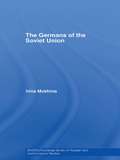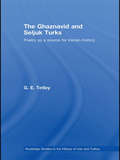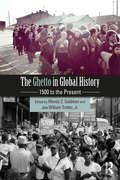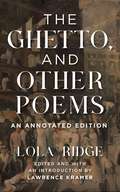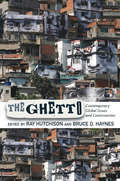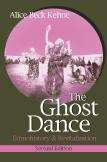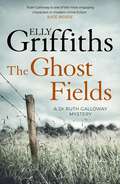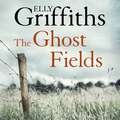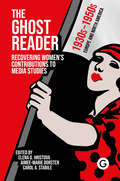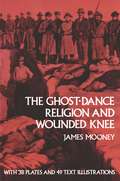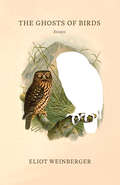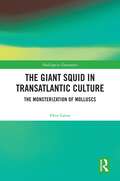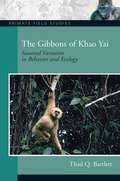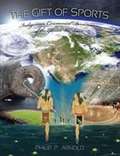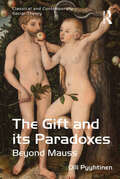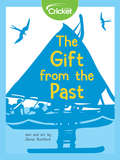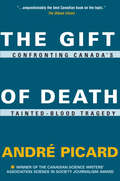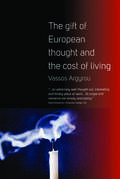- Table View
- List View
The Germans of the Soviet Union (BASEES/Routledge Series on Russian and East European Studies #Vol. 32)
by Irina MukhinaThe Germans were a very substantial minority in Russia, and many leading figures, including the Empress Catherine the Great, were German. Using rarely seen archival information, this book provides an account of the experiences of the Germans living in the Soviet Union from the early post-revolution period to the post-Soviet era following the collapse of communism. Setting out the history of this minority group and explaining how they were affected by the Soviet regime’s nationality policies, the book: describes the character of the ethnic Germanic groups, demonstrating their diversity before the execution of the policy of systematic deportations by the Stalinist authorities from 1937 to 1947 argues that there was not one but several episodes of deportation within this period considers the different dimensions of this policy, including the legal and economic structures of, and everyday life in, the Soviet special settlements investigates the ‘women’s dimension’ of deportation, especially the role of women in the preservation of ethnic identity among the afflicted groups explores the long term consequences of Soviet deportations and exile on the identity of the Soviet Germans.
The Gestural Communication of Apes and Monkeys
by Josep Call; Michael TomaselloThe Gestural Communication of Apes and Monkeys is an intriguing compilation of naturalistic and experimental research conducted over the course of 20 years on gestural communication in primates, as well as a comparison to what is known about the vocal communication of nonhuman primates. The editors also make systematic comparisons to the gestural communication of prelinguistic and just-linguistic human children. An enlightening exploration unfolds into what may represent the starting point for the evolution of human communication and language. This especially significant read is organized into nine chapters that discuss:*the gestural repertoire of chimpanzees;*gestures in orangutans, subadult gorillas, and siamangs;*gestural communication in Barbary macaques; and*a comparison of the gestures of apes and monkeys. This book will appeal to psychologists, anthropologists, and linguists interested in the evolutionary origins of language and/or gestures, as well as to all primatologists. A CD insert offers video of gestures for each of the species.
The Ghazi Sultans and the Frontiers of Islam: A comparative study of the late medieval and early modern periods (Routledge Studies in Middle Eastern History)
by Ali AnooshahrThe Ghazi Sultans were frontier holy-warrior kings of late medieval and early modern Islamic history. This book is a comparative study of three particular Ghazis in the Muslim world at that time, demonstrating the extent to which these men were influenced by the actions and writings of their predecessors in shaping strategy and the way in which they saw themselves. Using a broad range of Persian, Arabic and Turkish texts, the author offers new findings in the history of memory and self-fashioning, demonstrating thereby the value of intertextual approaches to historical and literary studies. The three main themes explored include the formation of the ideal of the Ghazi king in the eleventh century, the imitation thereof in fifteenth and early sixteenth century Anatolia and India, and the process of transmission of the relevant texts. By focusing on the philosophical questions of ‘becoming’ and ‘modelling’, Anooshahr has sought alternatives to historiographic approaches that only find facts, ideology, and legitimization in these texts. This book will be of interest to scholars specialising in Medieval and early modern Islamic history, Islamic literature, and the history of religion.
The Ghaznavid and Seljuk Turks: Poetry as a Source for Iranian History (Routledge Studies in the History of Iran and Turkey)
by G.E. TetleyThis new view on aspects of the Ghaznavid and Seljuk dynasties concentrates on the relationship of the panegyric poets Farrukhi Sistani (c.995-1032) and Mu'izzi (c.1045-1127) to the Ghaznavid and Seljuk rulers and dignitaries for whom they wrote. Dr Tetley investigates the reliability of the historical information which may be gathered from the poems, and draws comparisons with other historical sources. A solid and impressive work of learning, of interest to scholars in Oriental Studies, Medieval Literature, and History, The Ghaznavid and Seljuk Turks: Poetry as a Source for Iranian History, is the first extended English study of Mu'izzi it presents much new material concerning both this little-studied poet and also the better-known Farrukhi. Additionally, there is a valuable exploration of the relationship between Persians and Turks, a highly significant factor during the rule of the two dynasties.
The Ghetto
by Bruce D. Haynes Ray HutchisonToo often the term "ghetto" is simply applied to any African American community, to the inner city as a whole, or recently to anything that is degraded or unrefined. But what is a ghetto? Does it arise organically from cities, or is it a consequence of social conflict and government policy? Are the banlieues, barrios, favelas, shantytowns, and slums of Europe, South America, and other continents similar to the American ghetto?The Ghetto invites us to reexamine our assumptions by addressing these and other critical questions. Concise, original essays from top scholars around the world clearly describe essential arguments and discoveries, making the current discussion of marginalized urban spaces accessible for all readers and students of urban studies and sociology.
The Ghetto in Global History: 1500 to the Present
by Wendy Z. Goldman Joe William Trotter Jr.The Ghetto in Global History explores the stubborn tenacity of ‘the ghetto’ over time. As a concept, policy, and experience, the ghetto has served to maintain social, religious, and racial hierarchies over the past five centuries. Transnational in scope, this book allows readers to draw thought-provoking comparisons across time and space among ghettos that are not usually studied alongside one another. <P><P> The volume is structured around four main case studies, covering the first ghettos created for Jews in early modern Europe, the Nazis' use of ghettos, the enclosure of African Americans in segregated areas in the United States, and the extreme segregation of blacks in South Africa. The contributors explore issues of discourse, power, and control; examine the internal structures of authority that prevailed; and document the lived experiences of ghetto inhabitants. By discussing ghettos as both tools of control and as sites of resistance, this book offers an unprecedented and fascinating range of interpretations of the meanings of the "ghetto" throughout history. It allows us to trace the circulation of the idea and practice over time and across continents, revealing new linkages between widely disparate settings. <P><P> Geographically and chronologically wide-ranging, The Ghetto in Global History will prove indispensable reading for all those interested in the history of spatial segregation, power dynamics, and racial and religious relations across the globe.
The Ghetto, and Other Poems: An Annotated Edition
by Lola RidgeAt last recovered in this enriching annotated edition, this important but neglected work of American modernism offers a unique poetic encounter with the Jewish communities in New York’s Lower East Side.Long forgotten on account of her gender and left-wing politics, Lola Ridge is finally being rediscovered and read alongside such celebrated contemporaries as Hart Crane, William Carlos Williams, and Marianne Moore—all of whom knew her and admired her work. In her time Ridge was considered one of America’s leading poets, but after her death in 1941 she and her work effectively disappeared for the next seventy-five years. Her book The Ghetto and Other Poems, is a key work of American modernism, yet it has long, and unjustly, been neglected. When it was first published in 1918—in an abbreviated version in The New Republic, then in full by B. W. Huebsch five months later—The Ghetto and Other Poems was a literary sensation. The poet Alfred Kreymbourg, in a Poetry Magazine review, praised “The Ghetto” for its “sheer passion, deadly accuracy of versatile images, beauty, richness, and incisiveness of epithet, unfolding of adventures, portraiture of emotion and thought, pageantry of pushcarts—the whole lifting, falling, stumbling, mounting to a broad, symphonic rhythm.” Louis Untermeyer, writing in The New York Evening Post, found “The Ghetto” “at once personal in its piercing sympathy and epical in its sweep. It is studded with images that are surprising and yet never strained or irrelevant; it glows with a color that is barbaric, exotic, and as local as Grand Street.”The long title poem is a detailed and sympathetic account of life in the Jewish Ghetto of New York’s Lower East Side, with particular emphasis on the struggles and resilience of women. The subsequent section, “Manhattan Lights,” delves further into city life and immigrant experience, illuminating life in the Bowery. Other poems stem from Ridge’s lifelong support of the American labor movement, and from her own experience as an immigrant. This critical edition seeks to recover the attention The Ghetto, and Other Poems, and in particular the title poem, lost after Ridge’s death. The poems in the volume are as aesthetically strong as they are historically revealing. Their language combines strength and directness with startling metaphors, and their form embraces both panoramic sweep and lyrical intensity. Expertly edited and annotated by Lawrence Kramer, this first modern edition to reproduce the full 1918 publication of The Ghetto and Other Stories offers all the background and context needed for a rich, informed reading of Lola Ridge’s masterpiece.
The Ghetto: Contemporary Global Issues and Controversies
by Ray HutchisonToo often the term ?ghetto? is simply applied to any African American community, to the inner city as a whole, or recently to anything that is degraded or unrefined. But what is a ghetto? Does it arise organically from cities, or is it a consequence of social conflict and government policy? Are the banlieues, barrios, favelas, shantytowns, and slums of Europe, South America, and other continents similar to the American ghetto?The Ghetto invites us to reexamine our assumptions by addressing these and other critical questions. Concise, original essays from top scholars around the world clearly describe essential arguments and discoveries, making the current discussion of marginalized urban spaces accessible for all readers and students of urban studies and sociology.
The Ghost Cities of Australia: A Survey Of New City Proposals And Their Lessons For Australia's 21st Century Development (SpringerBriefs in Geography)
by Julian BolleterThis book examines failed new city proposals in Australia to understand the hurdles – environmental, societal, and economic – that have curtailed such visions. The lessons from these relative failures are important because, if projections for Australia’s 21st century population growth are borne out, we will need to build new cities this century. This is particularly the case in northern Australia, where the federal government projects a four-fold increase in population in the next four decades. The book aims that, when we commence 21st century new city dreaming, we have learnt from the mistakes of the past and, are not doomed to repeat them.
The Ghost Dance: Ethnohistory and Revitalization (2nd Edition)
by Alice Beck KehoeIn this ethnohistorical case study of North American Indians, the Ghost Dance religion is the backbone for Alice Kehoe's exploration of significant aspects of American Indian life and her quest to learn why some theories become popular. In Part 1, she combines knowledge gained from her first and experiences living among and speaking with Indian elders with a careful analysis of historical accounts, providing a succinct yet insightful look at people, events, and institutions from the 1800s to the present. She clarifies unique and complex relationships among Indian peoples and dispels many of the false pretenses promoted by United States agencies over two centuries. In Part 2, Kehoe surveys some of the theories used to analyze the events described in Part 1, allowing readers to see how theories develop, to think critically about various perspectives, and to draw their own conclusions.
The Ghost Fields: A gripping mystery from the bestselling author of The Last Remains (The Dr Ruth Galloway Mysteries #7)
by Elly GriffithsA bullet-ridden body is unearthed from a buried WW2 plane - but the body isn't from WW2. Dr Ruth Galloway, forensic archaeologist, must discover who the victim was, and who put him there.'Galloway now seems as real as Marple and Morse' The TimesWhen DCI Harry Nelson calls Ruth Galloway in to investigate a body found inside a buried fighter plane, she quickly realizes that the skeleton couldn't possibly be the pilot. DNA tests identify the man as Fred Blackstock, a local aristocrat who had been reported dead at sea. Events are further complicated by a TV company that wants to make a film about Norfolk's deserted air force bases, the so-called Ghost Fields, which have been partially converted into a pig farm run by one of the younger remaining Blackstocks. Then human bones are found on the farm and, as the greatest storm Norfolk has seen for decades brews in the distance, another Blackstock is attacked. Can the team outrace the rising flood to find the killer?***************************What readers are saying about The Ghost Fields'Wonderful characters . . . A must read' 5* Reader Review'Such a great series' 5* Reader Review'Elly Griffiths is my favourite author' 5* Reader Review'A real page-turner . . . an exciting read' 5* Reader Review'Thoroughly recommended' 5* Reader Review
The Ghost Fields: The Dr Ruth Galloway Mysteries 7 (The Dr Ruth Galloway Mysteries #7)
by Elly GriffithsA bullet-ridden body is unearthed from a buried WWII plane. Dr Ruth Galloway must discover who the victim was - and who put him there.When DCI Harry Nelson calls Ruth Galloway in to investigate a body found inside a buried fighter plane, she quickly realizes that the skeleton couldn't possibly be the pilot. DNA tests identify the man as Fred Blackstock, a local aristocrat who had been reported dead at sea. Events are further complicated by a TV company that wants to make a film about Norfolk's deserted air force bases, the so-called Ghost Fields, which have been partially converted into a pig farm run by one of the younger remaining Blackstocks. Then human bones are found on the farm and, as the greatest storm Norfolk has seen for decades brews in the distance, another Blackstock is attacked. Can the team outrace the rising flood to find the killer?(P)2015 Quercus Editions Ltd
The Ghost Reader: Recovering Women’s Contributions to Media Studies
by Elena D. Hristova, Aimee-Marie Dorsten, and Carol A. StabileThe scholarship, research, and criticism of women who developed key theories of communication and methods for the study of media.The Ghost Reader: Recovering Women&’s Contributions to Media Studies offers a fresh perspective on the intellectual history of the field of media studies, a broad scholarly field that encompasses the interdisciplinary and overlapping fields of media studies, cultural studies, and communication studies. By recovering the work of the diverse group of women who labored at the margins of media studies as it took shape during the formative years of communication research between the 1930s and the 1950s, and providing scholarly contexts for this work, The Ghost Reader shows that &“intersectional considerations&” were key modes of engagement for intellectuals, academics, and activists who happened to be women. They did so decades before feminist perspectives were reintegrated into histories of the field.
The Ghost-Dance Religion and Wounded Knee (Native American)
by James MooneyImmediately following the massacre of Wounded Knee (December 29, 1890), the well-known anthropologist James Mooney, under the auspices of the Bureau of American Ethnology and the Smithsonian, investigated the incident. His interest was primarily in the Indian background to the uprising. Admitting that the Indians had been generally overpowered by the Whites, what led the Indians to think they stood a chance against White arms? His answer was astonishing: the Ghost-Dance Religion.Investigating every Indian uprising from Pontiac to the 1980s, every Indian resistance to aggression, every incident of importance, Mooney discovered a cultural pattern: a messianic religion that permeated leaders and warriors from Tecumseh and his brother The Prophet on up to the Plains tribes that revived the Ghost-Dance in the 1880s and 90s. The message was: abandon the ways of the Whites; go back to Indian ways; an Indian messiah is coming; the Indian dead are to be resurrected — indeed, some have already returned; and the Whites are to be killed by the Spirits.Mooney made an exhaustive study of this cult, the rise of its latest version, diffusion to the Plains, and its relevance to the medicine man Sitting Bull and others. Citing many primary documents as well as anthropological data he gathered himself, Mooney gives an extremely detailed, thorough account of the cult; its songs and dances, ceremonies, and its social impact.This work has always been considered one of the great classics of American anthropology, a book that not only offers an account of a very interesting cultural phenomenon, but also throws light on many events in Indian-White relations that are otherwise dark. Its data have never been superseded and the book remains a work of primary importance in Native American studies.
The Ghosts of Birds
by Eliot WeinbergerA new collection from "one of the world's great essayists" (The New York Times) The Ghosts of Birds offers thirty-five essays by Eliot Weinberger: the first section of the book continues his linked serial-essay, An Elemental Thing, which pulls the reader into "a vortex for the entire universe" (Boston Review). Here, Weinberger chronicles a nineteenth-century journey down the Colorado River, records the dreams of people named Chang, and shares other factually verifiable discoveries that seem too fabulous to possibly be true. The second section collects Weinberger's essays on a wide range of subjects--some of which have been published in Harper's, New York Review of Books, and London Review of Books--including his notorious review of George W. Bush's memoir Decision Points and writings about Mongolian art and poetry, different versions of the Buddha, American Indophilia ("There is a line, however jagged, from pseudo-Hinduism to Malcolm X"), Béla Balázs, Herbert Read, and Charles Reznikoff. This collection proves once again that Weinberger is "one of the bravest and sharpest minds in the United States" (Javier Marías).
The Giant Carrot
by Barry Root Jan PeckA Tall tale about the power of teamwork<P><P> When sweet Little Isabelle's family plants a carrot seed one day, tall Papa Joe, wide Mama Bess, and strong Brother Abel all do their part. But when Little Isabelle wants to help too, Brother Abel just laughs. "What can you do?" he asks. "I'll sing and dance to the carrot to make it grow", she says. "And come summer, we'll have little cups of sweet carrot puddin'". Sure enough, that carrot takes a fancy to Little Isabelle's singing and dancing and grows to an amazing height -- proving that great things can be accomplished when everyone works together. <P> Based on an old Russian folktale, and complete with a scrumptious recipe for carrot puddin', this wonderfully humorous story shows the strength of teamwork and the power of a touch of imagination.
The Giant Squid in Transatlantic Culture: The Monsterization of Molluscs (Multispecies Encounters)
by Otto LatvaThis book builds upon the extensive study of the historical relationship between sea animals and humans in transatlantic culture during the eighteenth and nineteenth centuries. It exposes the present understanding of the human relationship with the giant squid not only as too simplistic but also as historically inaccurate. For instance, it redefines the earlier understanding that humans and especially seafarers have understood giant squid as horror-evoking and ugly creatures since the dawn of history and explains the origins of mythical sea monsters such as the Kraken. The book is, however, more than a critical response to previous work. It will point out that animals such as cephalopods, which have largely been defined in biological contexts in recent times, have a fascinating and multivariate past, entangled with the history of humans in many remarkable ways. Hence, this book is not just about perceptions of giant-sized squid or cephalopods, but a historical inquiry into the transatlantic culture from the late eighteenth century to the turn of the twentieth century. It will provide new knowledge about the history of mollusc studies, seafaring culture and more broadly of the relationship between humans and animals during the period.
The Gibbons of Khao Yai: Seasonal Variation in Behavior and Ecology, CourseSmart eTextbook (Primate Field Studies)
by Thad Q. BartlettPrimatologists have long viewed small fruiting trees, like figs, as the reason for gibbons’ territorial and monogamous behavior. However, at Khao Yai National Park in Thailand where gibbons are prevalent, figs are one of the largest trees in the forest. In this long-term field study, Bartlett takes up this apparent contradiction, and follows gibbons as their major food sources wax and wane over time.This is an important reference on gibbons and the study of small apes which provides a thorough, expansive coverage of the relationship between fruit abundance and diet, range use, and intergroup interactions in Gibbon apes. The Gibbons of Khao Yai: Seasonal Variation in Behavior and Ecology provides an essential resource for students conducting research in this field.
The Gift
by The Macat TeamMarcel Mauss’s 1925 essay The Gift is an enduring classic of sociological and anthropological analysis by a thinker who is one of the founding fathers of modern anthropology. The Gift exploits Mauss’s high-level analytical and interpretative skills to produce a brilliant investigation of the forms, meanings, and structures of gift-giving across a range of societies. Mauss, along with many others, had noted that in a wide range of societies – especially those without monetary exchange or legal structures – gift-giving and receiving was carried out according to strict customs and unwritten laws. What he sought to do in The Gift was to analyse the structures that governed how and when gifts were given, received, and reciprocated in order to grasp what implicit and unspoken reasons governed these structures. He also wanted to apply his interpretative skills to asking what such exchanges meant, in order to explore the implications his analysis might have for modern, western cultures. In Mauss’s investigations, it became clear that gift-giving is, in many cultures, a crucial structural force, binding people together in a web of reciprocal commitments generated by the laws of gifting. Indeed, he concluded, gifts can be seen as the ‘glue’ of society..
The Gift Of Fear: And Other Survival Signals That Protect Us From Violence
by Gavin De BeckerTrue fear is a gift. Unwarranted fear is a curse. Learn how to tell the difference. <p><p> A date won't take "no" for an answer. The new nanny gives a mother an uneasy feeling. A stranger in a deserted parking lot offers unsolicited help. The threat of violence surrounds us every day. But we can protect ourselves, by learning to trust—and act on—our gut instincts. <p> In this empowering book, Gavin de Becker, the man Oprah Winfrey calls the nation's leading expert on violent behavior, shows you how to spot even subtle signs of danger—before it's too late. Shattering the myth that most violent acts are unpredictable, de Becker, whose clients include top Hollywood stars and government agencies, offers specific ways to protect yourself and those you love, including...how to act when approached by a stranger...when you should fear someone close to you...what to do if you are being stalked...how to uncover the source of anonymous threats or phone calls...the biggest mistake you can make with a threatening person...and more. Learn to spot the danger signals others miss. It might just save your life.
The Gift Of Sports: Indigenous Ceremonial Dimensions of the Games We Love
by Philip ArnoldThe origins of nearly all sports can be found in religious ceremonies. The Olympic Games and Sumo wrestling are clear examples of how civilizations, both ancient and modern, connect athletic performance and achievement to a higher spiritual plane - to an indescribable yet clearly recognized "something more." <p><p> The Gift of Sports will give readers an understanding of and appreciation for the religious dimensions of sports. The selections in the text demonstrate that the appeal and popularity of sports is based on viewing them, not just as business or entertainment, but as ceremony.
The Gift and its Paradoxes: Beyond Mauss (Classical and Contemporary Social Theory)
by Olli PyyhtinenBringing social theory and philosophy to bear on popular movies, novels, myths, and fairy tales, The Gift and its Paradoxes explores the ambiguity of the gift: it is at once both a relation and a thing, alienable and inalienable, present and poison. Challenging the nature of giving as reciprocal, the book engages critically with the work of Mauss and develops a new theory of the gift according to which the gift cannot be reduced to a model of exchange, but must instead entail a loss or sacrifice. Ultimately, the gift is examined in the book as the impossible occurrence of gratuitous giving. In addition to exploring the conditions of possibility and impossibility of the gift, the book draws on the thought of figures such as Derrida, Serres, Simmel, Cixous, Irigaray and Heidegger to argue for the relevance of the phenomenon of the gift to broader issues in contemporary social sciences. It takes up questions concerning the constitution of community and the processes by which people are included in or excluded from it, gender relations, materiality, the economy, and the possibility that death itself could be a gift, in the form of euthanasia or self-sacrifice. A rigorous yet accessible examination of the phenomenon of the gift in relation to a range of contemporary concerns, The Gift and its Paradoxes will appeal to scholars and students within sociology, philosophy, anthropology, political theory and film and literature studies.
The Gift from the Past
by James RumfordGenerations of navigators have passed down their knowledge about how to read the sky, waves, land, and sea to find their way. Read about one man whose ancient skills helped solve a mystery.
The Gift of Death: Confronting Canada's Tainted Blood Tragedy
by André PicardFew Canadians know of "Mr. L," an auto worker in Ontario who gave "the gift of life" in 1984 as part of a company blood donor drive. Many more will remember Kenneth Pittman, a 53-year-old heart patient, who died after being infected with AIDS -- from Mr. L's blood. They will also remember Mr. Pittman's wife, Rochelle, who contracted the virus from her husband because his doctor decided not to inform them of Mr. Pittman's fatal disease.This tragic story is a microcosm of Canada's blood scandal. For over a decade, bureaucratic dithering, profits-over-protection responses, a paternalistic medical establishment and uninformed victims combined to create the worst health-care disaster in Canadian history. More than 1,200 people have contracted AIDS from tainted blood -- and the dying continues.André Picard has produced the definitive analysis of this complex tragedy. All of the players are here -- public health officials who refused to take the "homosexual plague" seriously; the Red Cross, which worried about bad publicity and the bottom line; the too-little-too-late government that offered inadequate compensation for victims; and the arrogant medical establishment which sometimes took years to inform HIV patients of their condition; and most of all, the victims, who are paying for this betrayal with their lives.The Gift of Death is a call for a serious re-evaluation of an outdated blood system to ensure that a similar tragedy never occurs.
The Gift of European Thought and the Cost of Living
by Vassos ArgyrouEuropean thought is often said to be a gift to the rest of the world, but what if there is no gift as such? What if there is only an economy where every giving is also a taking, and every taking is also a giving? This book extends the question of economies by making a case for an "economy of thought" and a "political economy." It argues that all thinking and doing presupposes taking, and therefore giving, as the price to pay for taking; or that there exists a "cost of living," which renders the idea of free thinking and living untenable. The argument is developed against the Enlightenment directive to think for oneself as the means of becoming autonomous and shows that this "light," given to the rest of the world as a gift, turns out to be nothing.
